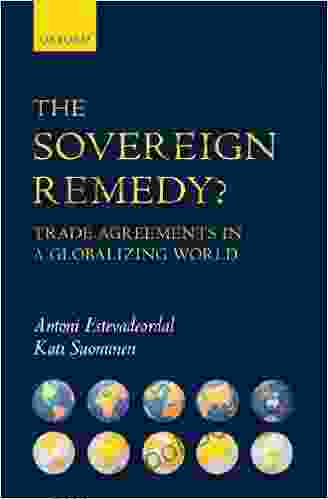Trade Agreements in a Globalizing World: A Comprehensive Guide

The world of international trade is an ever-evolving landscape, shaped by a complex web of agreements and regulations. Trade agreements play a pivotal role in fostering economic growth, promoting cooperation, and reducing barriers to trade between nations. This comprehensive guide delves into the intricate workings of trade agreements, examining their history, principles, benefits, and challenges. Whether you're a seasoned economist, a budding entrepreneur, or simply curious about the forces shaping the global economy, this guide will provide you with a deep understanding of the significance and implications of trade agreements.
4.6 out of 5
| Language | : | English |
| File size | : | 4829 KB |
| Print length | : | 288 pages |
| Lending | : | Enabled |
| X-Ray for textbooks | : | Enabled |
Historical Evolution of Trade Agreements
The origins of trade agreements can be traced back to ancient times, with rudimentary trade pacts emerging between neighboring communities and civilizations. Over the centuries, the concept of trade agreements evolved, influenced by factors such as technological advancements, political alliances, and economic theories.
The modern era of trade agreements began with the General Agreement on Tariffs and Trade (GATT) in 1947. GATT aimed to reduce trade barriers and promote fair trading practices among its member nations. It laid the foundation for the current multilateral trading system, which is overseen by the World Trade Organization (WTO).
Types of Trade Agreements
Trade agreements vary in their scope and objectives. The most common types of trade agreements include:
- Preferential trade agreements (PTAs): PTAs are agreements between two or more countries that provide preferential treatment to each other's goods and services. This may include reduced tariffs, quotas, or other trade barriers.
- Free trade agreements (FTAs): FTAs eliminate tariffs and other trade barriers on a wide range of goods and services between participating countries. FTAs aim to create a single market that promotes economic integration and efficiency.
- Customs unions: Customs unions are similar to FTAs, but they also involve the establishment of a common external tariff on goods originating from non-member countries.
- Economic unions: Economic unions go beyond customs unions by incorporating additional elements such as a common currency, a common monetary policy, and a free movement of labor and capital.
- Multilateral trade agreements: Multilateral trade agreements are agreements between multiple countries that cover a wide range of trade-related issues. The WTO is the primary forum for negotiating and enforcing multilateral trade agreements.
Benefits of Trade Agreements
Trade agreements offer numerous benefits to participating countries, including:
- Increased trade volume: Trade agreements reduce barriers to trade, such as tariffs and quotas, which leads to an increase in the volume of traded goods and services.
- Lower prices: Increased competition from imported goods and services can drive down prices for consumers, making them better off.
- Economic growth: Trade agreements stimulate economic growth by expanding markets for businesses and creating new job opportunities.
- Innovation: Trade agreements foster innovation by promoting the exchange of ideas and technologies between different countries.
- Cooperation: Trade agreements promote cooperation between countries and play a significant role in maintaining peaceful and stable international relations.
Challenges of Trade Agreements
Despite their numerous benefits, trade agreements also present certain challenges:
- Reduced government revenue: Trade agreements that reduce tariffs and import duties can lead to a decrease in government revenue.
- Job losses: In some cases, trade agreements may lead to job losses in industries that face increased competition from imports.
- Environmental concerns: Trade agreements can have environmental implications if they promote the production and consumption of goods and services in a way that harms the environment.
- Political resistance: Trade agreements may face political opposition from groups that fear negative impacts on domestic industries or workers.
- Enforcement: Ensuring compliance with trade agreements can be a complex and challenging task, particularly in cases where countries violate their commitments.
The Way Forward: Balancing Benefits and Challenges
The future of trade agreements lies in finding a balance between their potential benefits and challenges. To maximize the benefits and mitigate the risks, policymakers and negotiators must:
- Consider the impact on specific industries and workers: Trade agreements should be carefully designed to minimize negative impacts on particular industries and workers who may be vulnerable to import competition.
- Provide support for trade adjustment: Governments should provide assistance to workers and businesses that are negatively affected by trade agreements to help them transition to new opportunities.
- Promote transparency and accountability: Trade agreements should be transparent and subject to public scrutiny to ensure that they are fair and beneficial to all participating countries.
- Strengthen dispute resolution mechanisms: Robust and effective dispute resolution mechanisms are essential to ensure that countries comply with their commitments under trade agreements.
- Encourage stakeholder engagement: Governments and international organizations should engage with businesses, labor unions, environmental groups, and other stakeholders throughout the trade agreement negotiation and implementation process.
Trade agreements play a crucial role in shaping the global economy and driving economic growth. Understanding the history, principles, benefits, and challenges associated with trade agreements is essential for policymakers, economists, business leaders, and anyone interested in the intricacies of international trade. By embracing a balanced approach that maximizes the benefits while mitigating the risks, we can harness the power of trade agreements to create a more prosperous and interconnected world.
For further exploration of this fascinating topic, I highly recommend the following resources:
- World Trade Organization
- United Nations Conference on Trade and Development
- Organisation for Economic Co-operation and Development (OECD)
4.6 out of 5
| Language | : | English |
| File size | : | 4829 KB |
| Print length | : | 288 pages |
| Lending | : | Enabled |
| X-Ray for textbooks | : | Enabled |
Do you want to contribute by writing guest posts on this blog?
Please contact us and send us a resume of previous articles that you have written.
 Book
Book Novel
Novel Page
Page Chapter
Chapter Text
Text Story
Story Genre
Genre Reader
Reader Library
Library Paperback
Paperback E-book
E-book Magazine
Magazine Newspaper
Newspaper Paragraph
Paragraph Sentence
Sentence Bookmark
Bookmark Shelf
Shelf Glossary
Glossary Bibliography
Bibliography Foreword
Foreword Preface
Preface Synopsis
Synopsis Annotation
Annotation Footnote
Footnote Manuscript
Manuscript Scroll
Scroll Codex
Codex Tome
Tome Bestseller
Bestseller Classics
Classics Library card
Library card Narrative
Narrative Biography
Biography Autobiography
Autobiography Memoir
Memoir Reference
Reference Encyclopedia
Encyclopedia Anthony Wood
Anthony Wood Lauren Willig
Lauren Willig David Stubbs
David Stubbs Genevieve Graham
Genevieve Graham Debbie Howells
Debbie Howells Gregg Squeglia
Gregg Squeglia Megan Dowd Lambert
Megan Dowd Lambert Nikki Loney
Nikki Loney Marie Moore
Marie Moore Asa Mckercher
Asa Mckercher H Terrell Griffin
H Terrell Griffin Ayesha Siddiqa
Ayesha Siddiqa Anthony Mitchell Sammarco
Anthony Mitchell Sammarco David Hendrix
David Hendrix Phillip G Henderson
Phillip G Henderson Antony Felix
Antony Felix Antje Gillingham
Antje Gillingham B J Daniels
B J Daniels Anthony Lewis
Anthony Lewis Ashley Elizabeth
Ashley Elizabeth
Light bulbAdvertise smarter! Our strategic ad space ensures maximum exposure. Reserve your spot today!

 Owen SimmonsTeaching Concert Band In Today's Schools For Today's Students: A Guidebook...
Owen SimmonsTeaching Concert Band In Today's Schools For Today's Students: A Guidebook...
 Fernando BellEmbark on an Extraordinary Literary Journey: "Down the Amur to Peking and the...
Fernando BellEmbark on an Extraordinary Literary Journey: "Down the Amur to Peking and the...
 Chandler WardCollection of Poems by History's Greatest Writers: A Literary Treasury to...
Chandler WardCollection of Poems by History's Greatest Writers: A Literary Treasury to... Garrett BellFollow ·8.1k
Garrett BellFollow ·8.1k Tim ReedFollow ·3k
Tim ReedFollow ·3k Dean CoxFollow ·6.6k
Dean CoxFollow ·6.6k Gene SimmonsFollow ·14k
Gene SimmonsFollow ·14k Ken FollettFollow ·17.4k
Ken FollettFollow ·17.4k Christopher WoodsFollow ·18.8k
Christopher WoodsFollow ·18.8k Brennan BlairFollow ·2.6k
Brennan BlairFollow ·2.6k Ethan GrayFollow ·3.6k
Ethan GrayFollow ·3.6k

 Gabriel Garcia Marquez
Gabriel Garcia MarquezLad Dog Baby Professor: The Perfect Book for Your Child
Lad Dog Baby...

 Fredrick Cox
Fredrick CoxAn Excerpt With Fifty Ways To Help Animals Promo Books:...
: Embracing Animal...

 Kelly Blair
Kelly Blair5th Grade US History: Famous US Authors: Fifth Grade...
Step into a captivating world of historical...

 Natsume Sōseki
Natsume SōsekiKull the Destroyer: A Timeless Tale of Sword and Sorcery
The Creation of a...

 Jim Cox
Jim CoxDas Ist Supertoll: Unlocking the Magic of German for Kids
Immersive Learning with...

 Bruce Snyder
Bruce SnyderUnlock the World of Quilting for Kids: Discover "Quick...
Are you ready to embark on a delightful...
4.6 out of 5
| Language | : | English |
| File size | : | 4829 KB |
| Print length | : | 288 pages |
| Lending | : | Enabled |
| X-Ray for textbooks | : | Enabled |





